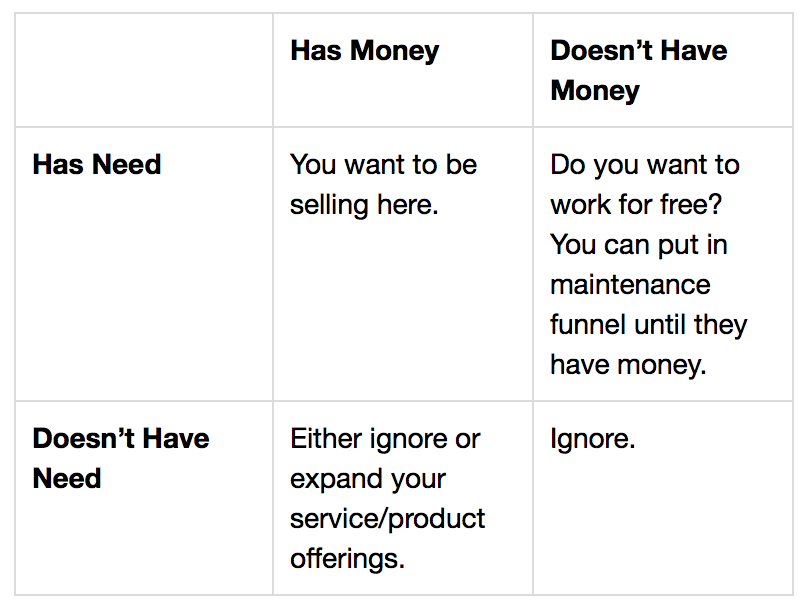When you’re starting your business or taking your freelancing career from one-off clients to full consulting gigs, it’s easy to take what you can get. Especially if you come from the startup world, you may want to sell into early stage startups. You know the world well, you know what their problems are, and they don’t have complex, bureaucratic sales systems.
You should fight this temptation.
Get out of selling to early stage startups as quickly as you can. Use your existing connections to do work that brings you case studies and great testimonials, but don’t rely on early stage startups for your business.
Selling to early stage startups looks easier and often requires less work on the customer acquisition side. The issue is that it’s not a sustainable business model for you or your team as your company grows.
I know. I learned this the hard way. After I left doing Business Development at Praxis (which generally did very well selling to high-growth startups…not all early stage startups are high-growth, though), I did some consulting for different companies. It made sense to tap into the world I immediately knew, which started with startups. I learned very quickly to differentiate between high-growth startups and purely early stage startups. High-growth startups didn’t spend a long time in the “early stage startup” phase, where the company is still trying to find product-market fit and focusing on honing in the business model.
Issues with Selling to Early Stage Startups
Like I said, there are perks to selling to early stage startups. They tend to have few employees, clear decision-makers, and are open to discussing what their issues are. Decisions move quickly (at least compared to the weeks it can take to move between departments and Vice Presidents at large companies) and it usually isn’t difficult to get an executive on the phone.
The downsides quickly become apparent, though.
Many Early Stage Startups Don’t Have a Revenue (Products vs. Businesses)
When I teach Business Development techniques to my career clients, one of the first things we discuss is incentives. What are the incentives of the decision makers you want to talk to? What are the incentives of their bosses? How does the company make money? Where are the biggest points where the company loses money?
(The advanced version of this technique is Incentive Mapping, an exercise I teach in communication workshops and career courses.)
This lets us then move the question to how can we help them make more, look better, and lose less money?
This is a powerful reframe from the traditional, “here, let me tell you about what my product/service/resume is!” It helps shift the conversation from, “look how great I am!” to “look how I can help you.”
The issue with a lot of early stage companies is that they have yet to hit product-market fit. Some don’t even have a business model yet. This is less common today than a few years ago when startups would acquire tens or hundreds of thousands of users and say, “we’ll monetize them later,” but this still happens, especially in technology.
If the company doesn’t have a clear business model, that doesn’t mean that you can’t sell to them. It means that selling to them is a lot harder, though. It means you can’t frame your pitch in terms of, “I will help you make more money by doing X.”
It also makes it harder for decision-makers in the company to justify purchasing your services. They have to go further to justify to their team that spending money on you, when they aren’t making money themselves, makes sense.
If you can’t clearly tell how the company makes money, especially after talking to people at the company, they may not make money at all and simply run on venture capital funding.
Early Stage Startups Don’t Have Money
Your customer should have a need you can solve and the ability to pay.
If they don’t have a need you can solve, you can either ignore them or expand your product offerings so that you can solve a need of theirs. If they don’t have money to pay you, you can either ignore them or you can put them in a maintenance funnel (checking in with them occasionally) until they get to a point where they can pay you.
Many startups run with negative or slim margins for years. They stay afloat either on small profits and low costs (tech companies don’t have a lot of overhead) or on a growth model that shows they will have explosive growth in the long-run (in which case, venture capital investment keeps them afloat).
Early stage startup employees take massive pay cuts compared to what they can earn in a bigger organization. This is made up for in equity compensation. Consultants are usually paid more than what their full-time counterpart would earn per hour because companies don’t have to worry about benefits.
That’s fine and good so long as the company has the money to pay more per hour. If they don’t, you end up working for less than your market rate, earning closer to what an employee would earn, without the equity compensation.
Early Stage Startups Have A Lot on Their Plates
The list of tasks that any early stage startup has to get done on any given day is longer than a CVS receipt.
This means that working with you will A) not be a high priority for the company and B) could be a huge opportunity for scope creep. The managers have a thousand other tasks to accomplish in any given day and will either prioritize getting back to you and your requests lower than those tasks or they will offload those tasks onto you.
At a certain point, it’s just not worth your time, money, and energy to work with a client that’s hard to work with. Scope creep wears you down, diminishes your margins, and adds stress to working with the startup. At a larger organization used to working with consultants, expectations are clearer at the beginning of the engagement and the company often has a designated point person for working with outside consultants.
Churn
By definition, startups are more likely to fail than an established company.
Imagine pouring dozens of hours of work into cultivating a new client, maybe landing one low-margin project with them as a way to prove your competence with them, and then find out they failed to raise a new round of funding and have to shut down.
You want to keep your churn (i.e., the rate at which you lose existing clients) low. You can do this by providing great support, thanking your clients regularly, and being attuned to their needs (I recommend the book Never Lose a Customer Again on this topic). You can’t do this if your clients go out of business.
Entire six-, seven-, and even eight-figure businesses can be built on serving a small handful of clients really, really well. Focus on serving clients well that you can serve for years at a time.
How to Work With Early Stage Startups Intelligently
If you’re going to work with early stage startups, make sure that your communication and expectations are crystal clear. You let them know how long you’ll consult with them and what you’ll deliver them. If they can’t pay your full rate and you still want to work with them, use the opportunity to work with them to generate case studies, testimonials, and referrals.
If they can’t pay you or if their focus changes, keep them in a maintenance funnel. Reach out every couple of weeks to see how you can help and offer to hop on a call if the situation around working together has changed.
If it’s not a fit, though, don’t force a fit. You’ll both be better off working with somebody else.

